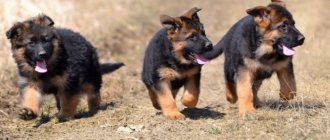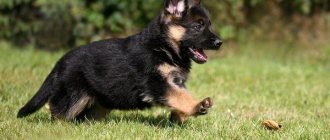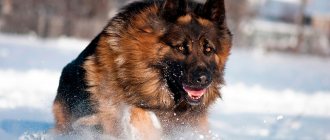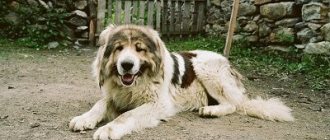At what age do you start training?
Puppy training must begin from the very first days
the presence of a dog in your home. Because already from infancy, the puppy must learn the rules of behavior in your house, what is allowed and what is forbidden, how to behave with all family members, even the smallest and oldest, what he can play with and what he can’t, where to go. toilet and much more.
And we are talking, first of all, about the proper upbringing of a German Shepherd puppy, and you can start training and learning commands when the puppy is completely comfortable in your home. As a rule, one week is enough. By this time, the puppy is already filled with curiosity and is diligently exploring the world around him. If, after this time, the puppy remains fearful and does not make contact well, then it is better to seek help from a dog handler-animal psychologist, because This behavior is not typical for puppies of this breed.
When can you start training with a dog handler?
The beginning of the puppy's training coincides with the time of the first exit to the street. When the first two vaccinations have already been done, the quarantine (lasts 7-14 days, depending on the vaccination) after them is over. It is not at all necessary to train your puppy only outside; the first sessions are best done at home, where there are fewer distractions.
Often new puppy owners worry that training from the first days will be excessively stressful for the dog. This is only possible if outdated, rigid methods are used, and with the right approach, training from the first days will, on the contrary, be very useful, since it allows you to immediately establish contact
with the puppy and build a trusting relationship.
You can start raising a puppy from the first days of its appearance in your home, and training and classes with a dog handler can begin simultaneously with the start of walks, when quarantine ends after the second vaccination.
Why you don't need to wait up to 6 months
We often hear that German Shepherds, like other dogs, cannot be trained before 6 months of age because training is stressful. This opinion remains from the times of outdated methods based on cruel coercion and intimidation of the dog. Unfortunately, there are still plenty of dog handlers using similar techniques today. But fortunately, science does not stand still and modern techniques make it possible to train a puppy from the first days in a new home. Therefore, you should not wait until your German Shepherd puppy develops unwanted behavior; you can start training much earlier.
Feeding shepherd puppies
You can start feeding the puppies at the moment when you notice a decrease in their daily growth and they become restless, whine and try to crawl. It is important to adhere to deadlines here - haste is just as dangerous as delay. If you start feeding too early, the mother's milk production, which is a source of vitamins and antibodies to various infections, will be reduced. In fact, mother's milk is the best serum that protects the litter from various types of infections.
Usually they start feeding babies on the fourteenth day. In cases where the shepherd has problems with lactation, you can start on the twelfth day. You can give cow, sheep or goat milk by mixing egg yolk and powdered milk into it.
A bottle with a nipple is suitable as a feeding tool - the hole should be of such a size that the milk does not flow, but drips. The frequency of feeding in case of insufficient lactation in a bitch is every three hours, in case of normal lactation - three times a day.
Training at 2 months. Upbringing
At 2 months old, your German Shepherd puppy is still at home, in quarantine after the first vaccinations, and he is not yet allowed to go for walks. Therefore, it’s time to start raising a puppy in the home conditions that are already familiar to him.
Toilet training
The first step is teaching the puppy to go to the toilet in a diaper . You should not rush to teach going to the toilet directly outside, bypassing this stage, because puppies are not physiologically ready for walking twice a day. This ability is developed in German Shepherd puppies no earlier than 6 months, and in some up to 1 year.
It should be remembered that any learning is a rather complex thing and, seeing the first positive results, you should not think that your puppy has already understood everything, but you should continue training according to the method, so that after a while you do not have to start all over again.
Collar and leash training
The second important point will be to accustom the puppy to a collar and leash . Yes, yes, this should be done at home, so that by the time the puppy goes outside for the first time, wearing a collar will not be additional stress for him, but is already a familiar thing, and he can start exploring the world around him, rather than trying to get rid of an unknown object.
What to allow a puppy and what not
The third point, which causes the greatest difficulty for new puppy owners, will be determining the puppy’s boundaries of what is permitted. Often, many novice dog owners think that the unwanted behavior of a German Shepherd puppy will “go away on its own, outgrow it.” But, unfortunately, the behavior that is allowed for a puppy will be taken for granted later by an adult dog.
.
Any unwanted behavior in a puppy WILL NOT go away on its own, but will only become stronger over time.
Therefore, it is necessary to start defining the puppy’s boundaries of what is permitted now. You will need:
- Teach to play only with your toys, and not with your things;
- Explain that you cannot bite your hands even in a game;
- Establish the correct daily routine, establishing the rule that in the morning you need to sleep and not wake you up;
- Stop chewing furniture, clothes, walls and baseboards;
- Teach to stay home alone, knowing that your absence is not a reason to bark or howl.
IT IS EXTREMELY IMPORTANT TO KNOW: constant and excessive punishments that follow almost every action of the puppy have a detrimental effect on its fragile psyche and can lead to the fact that the German Shepherd puppy grows up cowardly and embittered. For normal natural development, a puppy must have the opportunity to explore the world around him, which is currently limited to your apartment or house.
Introduction to Basic Commands
Already now you should begin to familiarize yourself with the initial obedience commands in a light playful form, while focusing on rewards for execution, because the puppy’s psyche is still quite plastic and excessive severity and exactingness can lead to the puppy being intimidated and cowardly. Therefore, it is necessary, first of all, to try to interest the puppy by offering him a toy or treat, and sometimes just praise.
Training at 3 months. Socialization
Three months is an important stage in a German Shepherd puppy’s introduction to the outside world. Your first walks should be short and not too tiring for the puppy. You should start with 15 minutes, gradually increasing the walking time to 1 hour.
Correct formation of the nervous system
At this age, the puppy’s nervous system is forming.
. It has been proven that raising puppies in isolation during this important period contributed to the development of pronounced cowardice in them later. It is necessary to show the puppy as much as possible: noisy streets, large crowds of people, etc. Everything that he will have to face in later life.
This must be done very carefully, gradually, over and over again increasing the time spent in noisy places, so as not to overload the puppy or frighten him.
The territory of a country house, cottage or village are places with a minimum amount of external stimuli for a city dog. Therefore, if you plan to keep a dog in an urban environment, “growing up” a German Shepherd puppy in such conditions depleted of irritants is unacceptable.
A city puppy must grow up in the city, in conditions that are saturated with external stimuli, such as: noisy streets, large crowds of people, other animals, birds, cyclists, cars, etc.
Meeting people and dogs
It is necessary to introduce the puppy to friendly dogs and people
so that later the puppy does not develop aggression or cowardice caused by the fear of new things and the inability to communicate and make new acquaintances. Currently, unfortunately, this is not uncommon in the behavior of adult dogs, but a fairly common problem with which people turn to our specialists for help.
Puppy behavior on the street
The emergence of new places leads to new rules that need to be consolidated:
- Now you can and should go to the toilet on the street, and not stoically endure it, carrying everything home;
- Not every new person or dog wants to communicate, so you don’t need to run headlong to meet everyone;
- Not all food is healthy, so it should only be taken from the owner’s hands.
Training and practicing commands
Training a puppy follows the same principles as at 2 months. It should be remembered that at this age puppies develop conditioned reflexes quite easily, but they are forgotten just as quickly, so you should not scold the puppy for not following commands, especially if they have not been repeated for a long time, but you should pay more attention to learning new things and repeating already covered material .
Postpartum care
Within 3-4 days after birth, it is necessary to increase the frequency of walks . The pet must be taken out upon request. It is preferable to use a protective apron during walks to cover the nipples and genitals of the female to prevent infectious contamination of the offspring and not herself. After a walk, you need to thoroughly wash your paws and treat the nipple area with a weak solution of manganese.
During lactation, you need to carefully care for your nipples. If cracks or signs of mastitis appear, treat the area with syntomycin ointment or apply a bandage with emulsion.
To form a sufficient amount of milk in a nursing shepherd dog during the postpartum period, it is necessary to provide the dog with free access to water; you can also use lacto-stimulating drugs, such as apilac.
Within 48 hours after birth, the animal may refuse to eat, but the mother in labor must be fed every 6-8 hours to provide the offspring with a sufficient amount of milk.
In the first 2-3 days, the dog is fed liquid food and milk porridges; broth and boiled meat are allowed in limited quantities. From the 4th day it is allowed to give the shepherd raw meat in small pieces, gradually increasing the portions.
During the postpartum period, the female and puppies require a diet rich in vitamins and minerals, so it is allowed to add meat and bone meal, glucose and ascorbic acid to the food.
It is recommended to gradually switch the shepherd dog to a regular diet from the moment the puppies begin to feed the puppies on their own.
Training at 4 - 5 months
By this time, the German Shepherd puppy has already become accustomed to your home and usual walking areas, and no longer needs your support and care so much. He begins to flirt with other dogs, pretend that he does not hear you when you call him, and show a certain persistence and disobedience when performing various commands.
This means it's time to move on to full training . In classes at this age you can already be persistent and demanding. At the same time, the most important thing is not to overdo it, remember that classes should bring joy to both you and your dog, and only then you can achieve the desired result.
Required commands in 4 months
What commands are practiced by a German Shepherd puppy at 4 months:
- Calm movement next
to the owner with and without a leash, with landing when stopping, with a change in pace and direction of movement - Return to you
upon request - Staying
in a free or certain position (sitting, lying, standing) for a long time: if necessary, wait for the owner on the street, when visiting a store or other establishment - Indifferent attitude towards treats scattered on the ground
- Inhibitory command
to stop unwanted actions - Execution of a set of commands “sit”, “lie down”, “stand”
at a distance and near the leg, when giving commands by voice and gestures - Stop barking
on demand.
German Puppy Feeding Basics
There are several nutrition schemes: dry industrial food, natural food and mixed feeding (a combination of the first two schemes). Each owner must decide what food to feed his German Shepherd puppy and choose a feeding plan that is convenient for him.
However, you should follow a few rules:
- Dry food for German Shepherd puppies must be of excellent quality (product class not lower than premium).
- A natural diet must be completely balanced.
- With a natural diet, the puppy is given mineral and multivitamin supplements.
- It is necessary to follow the feeding schedule (food is given to the pet strictly at the same time).
- Food should have a temperature of about 30-35 degrees.
- The puppy is provided with a bowl of clean drinking water.
- The pet is fed strictly after a walk or workout. After active pastime, at least half an hour should pass.
Proper feeding is the basis for proper raising of a puppy. An unbalanced diet will lead to the development of rickets. The baby will grow slowly and his ears may not rise. The presence of table foods containing spices and salt on the menu will lead to the development of chronic gastritis.
Training from 6 months
At this age, the puppy begins puberty and the real rebel awakens in him. He begins to re-test the boundaries of what is permitted and, sometimes, deliberately does not respond to your commands, only in order to look at your reaction. If she is not what the puppy expects to see, then he may decide that now he can no longer carry out your commands.
Remember that a puppy is still a child.
, and excessive harshness can forever undermine his trust in you.
At this stage of a German Shepherd puppy's growing up in training, all the shortcomings made at the previous stages, which were smoothed out by his young age, become clearly visible. And if they appear, it’s time to correct them.
In many training schools, there is an opinion that a puppy needs to be trained in two stages, the first at an early age, and the second at 8 - 10 months, in order to “consolidate” what has been learned. This is not an entirely correct position; this opinion appeared when newer operant training methods began to be added to the old “DOSAAF” rigid training methods, where they began to work with the puppy strictly after 6-7 months, including working with the method of pointing and following the “target”.
Their weakness was that they were two different techniques.
, which began to be used without adapting to each other, having a huge gap between their tools for developing training skills. The difference between them is like between choreography lessons in kindergarten and army drill training. Therefore, they required training in two stages, which were in no way connected with each other.
Modern methods based on zoopsychology make it possible to train a puppy in a single system , when no additional stages of training are required.
Our dog handlers
German Shepherd training specialists
Alexander Chaplygin Dog psychologist-zoopsychologist
Experience: 37 years Read more..
Ekaterina Panova Dog psychologist-zoopsychologist
Experience: 34 years Read more..
Yaroslav Morozov Dog psychologist-zoopsychologist
Experience: 25 years Read more..
Lada Yurtseva Dog psychologist-zoopsychologist
Experience: 21 years Read more..
Victoria Fox Dog psychologist-animal psychologist
Experience: 14 years Read more..
Ekaterina Budkina Dog psychologist-zoopsychologist
Experience: 13 years Read more..
Evgeniy Bravinsky Dog psychologist-zoopsychologist
Experience: 17 years Read more..
Vitalia Bravinskaya Dog psychologist-zoopsychologist
Experience: 10 years Read more..
Kira Ageeva Dog psychologist-zoopsychologist
Experience: 19 years Read more..
Evgenia Zuber Dog psychologist-zoopsychologist
Experience: 12 years Read more..
Tatyana Melnikova Dog psychologist-zoopsychologist
Experience: 10 years Read more..
Alexey Melikhov Dog psychologist-zoopsychologist
Experience: 22 years Read more..
* Check with the managers for the possibility of a specific specialist visiting the area you specified. If the desired dog handler does not work in your area, then we can offer you another specialist from the above.
Training a German Shepherd puppy in
When you turn to our dog training center for help in training a German Shepherd puppy, you can be sure that a real specialist in his field
and will provide training at the proper, highest level.
- A dog trainer will come to your
home at a time convenient for you. - Classes are held 1-2 times a week
, depending on the program. - Instructors work from 9:00 to 21:00
, on weekends inclusive - The training program is drawn up at the first lesson,
taking into account the breed, age, personal characteristics of the dog and your wishes for training - Some classes take place at home
, some
outside
, depending on the topic of the lesson. - Puppy age
from 2 months
Our Center employs dog handlers - animal psychologists who have experience in working with German Shepherd puppies and training adult dogs from 10 to 35 years old, who know all the nuances of their behavior
and features of training at each stage of a dog’s growth. Therefore, your pet is guaranteed to learn to carry out your commands the first time in any conditions, and will become your faithful and reliable companion.
How to create a diet from natural products
Nutrition for a German Shepherd puppy - with natural feeding - is quite difficult to create. The best option would be food - you do not need to prepare food every day and calculate the diet, add additional myriads and vitamins.
The quality of the products may not correspond to what is declared; when purchasing products, we cannot always say with certainty that they are fresh and without additives. Cooking, calculating, creating a diet and diversifying food is quite difficult.
So, when feeding with natural products: the diet is made up only of permitted products, and also in accordance with the needs:
- Per 1 kg of animal there should be about 20 grams of protein, everything else in proportions of 10 - porridge / cereals and 20% in vegetables / fruits / herbs / berries.
- The volume looks like this: 70% of the food will be meat/fish/dairy; 30% of the total volume for fruits/vegetables/porridge/greens.
- The diet is formed from permitted products, and a menu is prepared for each week.
Meat
Meat and meat products are introduced gradually. The very first time in pureed form, added to porridge. You can start accustoming them to natural products from 4 to 5 weeks of age.
The puppy receives meat from as little as 30 grams, gradually increasing the volume to 400 - 500 over 4 - 5 months.
As soon as the puppy grows up, you can chop it finely. The product must be raw, with veins and bones removed. It is enough to freeze it for 3 - 4 days, under this condition, the dog will not be infected with helminths.
It is allowed to feed the German Shepherd, but not with fatty meat:
- Beef;
- Rabbit;
- Veal;
- Chicken;
- Turkey.
Do not feed: lamb, pork.
By-products
The insides are rich in minerals and vitamins required for dogs. It is recommended to cook the entrails. In its raw form it is tripe. From 2.5-3 months, starting a little at a time. Before cooking, rinse and clean well.
- Trimmings – ears, lips, local sections;
- Tripe (tripe);
- Liver;
- Kidneys;
- Lung;
- Brain;
- Neck;
- Udder.
The entrails are given in larger quantities and added to the porridge. Be careful with the liver, it is not recommended to give only one product, it is important to alternate or combine them.
Fish and seafood
Sea fish is a source of phosphorus, as well as essential vitamins and acids. It and other seafood contain significant amounts of iodine and fluoride. The fish must be boiled, cleaned of entrails, bones and without the head.
Give seafood products 2 times a week. A larger quantity of product will be required than meat or offal.
It is forbidden to feed: river fish in any form.
Milk
Must be present in the diet. Soft cottage cheese (for children) begins to be introduced at 2 weeks. Then they switch to low-fat grains.
You can give: kefir, yogurt without additives, fermented baked milk, low-fat cheeses. While the puppy is growing, give milk 2 times a day, after 4 months, 1 time. Prodet is served separately from the main meal, as an afternoon snack or late dinner.
Eggs
Eggs are given as an addition to the main dish. Add 1 raw egg to the bowl. You can give cooked protein, but not more than 2 times a week. The yolk should always be raw.
Cereals
Just like meat products, it is given daily, the basis of the diet and its important addition.
- Buckwheat porridge;
- Rice;
- Oatmeal;
- Sometimes allowed in small quantities: wheat, barley.
Do not give: millet, legumes, pearl barley.
Vegetables, fruits and greens
Vegetables have a higher fiber content, as well as many vitamins necessary for the body. It is important to remember that most vegetables are given raw. Cooked and heat-treated vegetables are not healthy for dogs.
You can give:
- Tomato – sometimes;
- Cucumbers;
- Beet;
- Carrot;
- Zucchini;
- Pumpkin;
- Cabbage - broccoli, white cabbage;
- Bell peppers;
- Leafy green salad;
- Greenery.
From fruits: Bananas, apples, pears, berries, exclude citrus fruits.
It is forbidden to give to Germans
Eliminate the following from your dog's diet:
- Tubular bones;
- Mushrooms in any form;
- Grapes, plum;
- Potato;
- Pasta;
- Sugar and other sweets;
- Any spices;
- Dried fish;
- Semi-finished products, freezing;
- Pastries and bread;
- Any human food;
- Sausages, hot dogs, smoked meats.
Other products
As a treat and as an addition to the main diet, you can give: crackers; cartilage, large bones (not tubular).
Additionally given: bone meal, sometimes gelatin, vegetable oil.
Menu for 4 days for a puppy
- Monday:
Cottage cheese; Porridge with tripe and herbs; Vegetables/rice/greens; Kefir and apple.
- Tuesday:
Buckwheat with chicken and carrots; Cottage cheese with banana; Kefir; Cottage cheese with kefir.
- Wednesday
Rice with beef, zucchini, cucumber and herbs; Cottage cheese with pear; Rice with chicken, carrots and egg; Kefir and apple.
- Thursday
Hake with buckwheat, carrots, broccoli; Cottage cheese; Rice with zucchini, cucumbers, carrots, white cabbage; Kefir.











